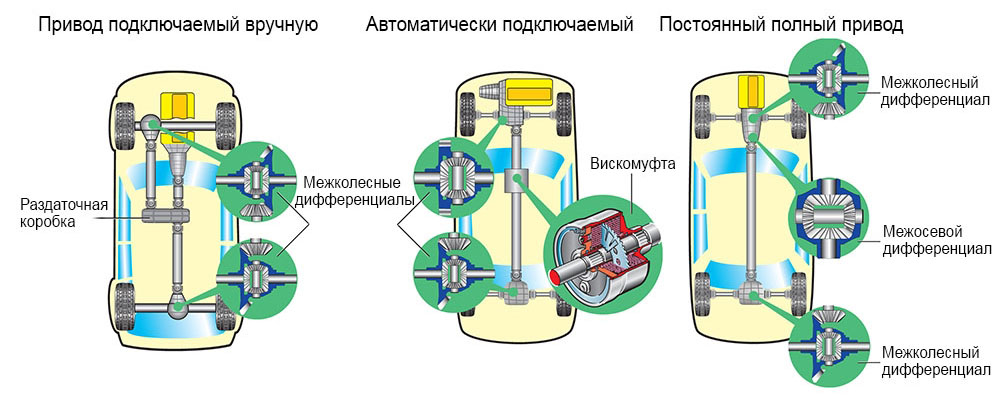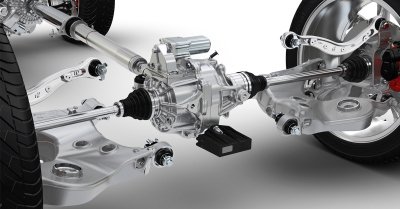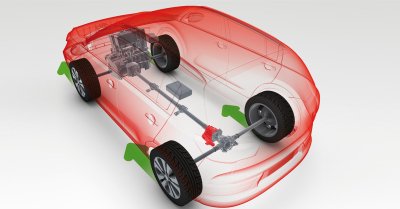
Types of drives and all-wheel drive systems
Content
Today there is no such motorist or even a novice driver who would not understand the fundamental difference between the types of vehicle drive. The essence of determining the drive on a car is simple and clear: in order for the car to start moving, the torque from the engine must be transferred to the wheels. How many wheels will receive torque and on which axle (rear, front or both) will depend on the type of drive.
Rear drive
 In the case of rear-wheel drive, the torque will be transmitted only to the wheels located on the rear axle of the car. To date, this principle of the device is considered the most common. The first rear-wheel drive cars came out back in the 1930s, and to this day this type is used both in the production of budget vehicles and for equipping expensive cars. For example, the Chevrolet Corvette 3LT 6.2 (466 horsepower) presented in the Favorit Motors group of companies is also equipped with rear-wheel drive. This allows the driver to feel more acutely all the available power of the car.
In the case of rear-wheel drive, the torque will be transmitted only to the wheels located on the rear axle of the car. To date, this principle of the device is considered the most common. The first rear-wheel drive cars came out back in the 1930s, and to this day this type is used both in the production of budget vehicles and for equipping expensive cars. For example, the Chevrolet Corvette 3LT 6.2 (466 horsepower) presented in the Favorit Motors group of companies is also equipped with rear-wheel drive. This allows the driver to feel more acutely all the available power of the car.
The specifics of the placement of this type of drive also implies the use of a cardan shaft. The shaft amplifies the energy coming from the motor apparatus.
Rear-wheel drive cars are often used not only in everyday life, but also in racing. Despite the fact that the driveshaft increases the weight of the car, the movement of the rear pair of wheels evenly distributes this weight.
In the automotive industry using rear-wheel drive, four types of layout of the propulsion unit are used:
- First, it is a front-engined rear-wheel drive layout, which is also called "classic". The engine itself in such cars is located in the front (under the hood), but its center of mass should be calculated as accurately as possible so that the energy transfer to the rear wheels is most efficient. The front-engine arrangement is by far the most commonly used option for equipping rear-wheel drive vehicles.
- Secondly, a front mid-engine rear-wheel drive layout is also used. Usually it is also included in the "classic" version of the engine location. However, in this case, the power unit is located in the area of the front wheelset. Today, this arrangement of engines in rear-wheel drive vehicles is found only in racing models to reduce the load on the front axle.
- Thirdly, the rear mid-engine rear-wheel drive layout. The motor is located directly at the rear axle, which makes it possible to use the weight of the car to increase its dynamic performance.
- Fourth, a rear-engine rear-wheel drive layout is an option when the power unit itself, as well as the transmission and drive axle, are located in the rear lower part of the vehicle. Today, this type of engine arrangement can only be found in some manufacturers, in particular, Volkswagen.
Benefits of a rear wheel drive car
 Cars equipped with a rear axle torque transfer device have many advantages in handling and dynamics:
Cars equipped with a rear axle torque transfer device have many advantages in handling and dynamics:
- the absence of vibrations on the body during movement (this is achieved due to the longitudinal arrangement of the power unit, which is structurally located on softening "pillows");
- the minimum turning radius, which allows you to technically use the vehicle in the busiest city parking lots or on narrow streets (the front pair of wheels only sets the direction of movement, the movement itself is performed by the rear pair);
- good acceleration performance.
Disadvantages of a rear wheel drive car
Like any other system, rear-wheel drive also has its drawbacks:
- the transmission of forces from the engine requires a cardan shaft, and its design features do not allow using all the possibilities without the presence of special tunnels. In turn, the cardan tunnels occupy a usable area by reducing the space in the cabin;
- low off-road patency, frequent drifts are possible.
Front-wheel drive
Front-wheel drive is considered the opposite of rear-wheel drive. In this case, the torque is transmitted exclusively to the front pair of wheels, causing them to rotate. For the first time such a principle in driving a car was serially introduced back in 1929.
The advantages of front-wheel drive allow it to be used more on cars in the budget sector (for example, Renault Logan). However, commercial vehicles equipped with front-wheel drive (Citroen Jumper) can also be bought at Favorit Motors.
The most important principle in the operation of a front-wheel drive car is the full compatibility of the mechanism for transmitting torque and the device for controlling the machine. This combination, on the one hand, makes it possible to simplify the driving process itself, and on the other hand, complicates the drive design itself.
In the automotive industry using front-wheel drive, the principles of the location of the power unit and gearbox should be especially clearly used so that control is not hindered by anything:
- Firstly, the main arrangement method is called a sequential layout (that is, the engine and gearbox are placed one after the other along the same axis);
- Secondly, a parallel layout is also possible, when the power unit and transmission are placed at the same height, but parallel to each other;
- Thirdly, the so-called "floor" layout is also used - that is, the motor is located above the gearbox.
Benefits of a front wheel drive car
 Cars equipped with front-wheel drive are considered more budgetary, since their production does not involve the use of auxiliary elements (such as a driveshaft and tunnels). However, low price is not the only advantage of front-wheel drive cars:
Cars equipped with front-wheel drive are considered more budgetary, since their production does not involve the use of auxiliary elements (such as a driveshaft and tunnels). However, low price is not the only advantage of front-wheel drive cars:
- good interior capacity (due to the lack of a cardan shaft);
- good cross-country ability even in off-road conditions;
- the ability to control on ice without skidding.
Disadvantages of a front wheel drive car
Due to the design of the car, the driver will notice the following disadvantages in driving:
- sensitive body vibrations while driving;
- large turning radius, as the hinge on the wheels is fully aligned with the steering device;
- the high cost of repair work, since it will be necessary to change components not only in the front-wheel drive device, but also in steering.
Four-wheel drive
All-wheel drive is a special vehicle transmission device that allows you to transmit torque to both axles at once. In this case, usually each pair of wheels receives an equal amount of energy for movement.
Initially, cars equipped with all-wheel drive were considered only as all-terrain vehicles, but later, in the 1980s, the fundamental developments of large concerns made it possible to introduce the 4WD principle to cars, which increased their cross-country ability without sacrificing comfort. To date, one of the most successful all-wheel drive systems can be called AWD (Volvo) and 4Motion (Volkswagen). New cars with such a device are always in stock at Favorit Motors.
Constant developments in the field of all-wheel drive have made it possible to single out four main schemes for its use at once:
- Plug-in 4WD (otherwise: Part-Time). This is the simplest and at the same time reliable all-wheel drive scheme. The essence of its work lies in the fact that during normal operation of the car, only one axis works. In the event of a change in road conditions (dirt, pits, ice, etc.), all-wheel drive is activated. However, due to the sensitive connection between the two drive axles, so-called "power circulation" can occur, which affects the strong wear of the elements and the loss of torque.
- Permanent 4WD (otherwise Full-Time). Cars connected to all-wheel drive in this way always use all four wheels as driving wheels. Usually Full-Time involves the use of a differential box, which regulates the supply of torque to the wheels depending on road conditions.
- Permanent on-demand 4WD (otherwise: On-Demand Full-Time). At its core, this is one of the varieties of all-wheel drive, but the connection is carried out automatically. Usually, one axle (often the front one) is permanently connected to 4WD, and the second one is partially connected, which allows not using two axles on a normal surface, and, if necessary, making a connection.
- Multi-mode 4WD (otherwise: Selectable). Used on the latest models. Four-wheel drive can have different modes of operation and be adjusted both by the driver himself and by automation, depending on road conditions.
Four-wheel drive vehicles can have three possible layout options:
- Firstly, the classic arrangement of the power unit and gearbox - the propulsion system is located under the hood, along with the transmission, and is placed longitudinally. The torque in this case is transmitted through the cardan.
- Secondly, it is possible to perform a layout based on a front-wheel drive. That is, the 4 WD system is mounted on a front-wheel drive vehicle, which allows the rear axle to be used only as an auxiliary one. The engine and gearbox are located in front of the car.
- Thirdly, with the rear placement of the power unit. The engine and transmission are located at the rear pair of wheels, while the main drive also falls on the rear axle. The front axle is connected both manually and automatically.
Benefits of an all-wheel drive car
Of course, the main advantage of cars with a 4WD system is their cross-country ability. Off-road conquest is easy, thanks to the reasonable distribution of engine power to each axle and wheel separately. In addition, all-wheel drive has a number of other advantages:
 stabilization of movement (even when cornering and at high speed, the car will not skid);
stabilization of movement (even when cornering and at high speed, the car will not skid);- no slippage;
- the ability to transport heavy trailers on any road surface.
Disadvantages of a car with all-wheel drive
Increased traction affects, first of all, fuel consumption:
- high fuel consumption;
- due to the complexity of the device, the repair is highly valued;
- noise and vibration in the cabin.
Results
When choosing a car for yourself, it is worth evaluating not only its external data and technical characteristics, but also the conditions under which it will be operated. When moving around the city, there is not much point in overpaying for 4 WD when you can get by with a budget front-wheel drive car.
It is also worth bearing in mind the cost of car maintenance. In the event of any defects or breakdowns, it is necessary not only to have additional funds for repairs, but also to know where to turn. Favorit Motors offers professional adjustment and repair of all types of drives at affordable prices.

 stabilization of movement (even when cornering and at high speed, the car will not skid);
stabilization of movement (even when cornering and at high speed, the car will not skid);